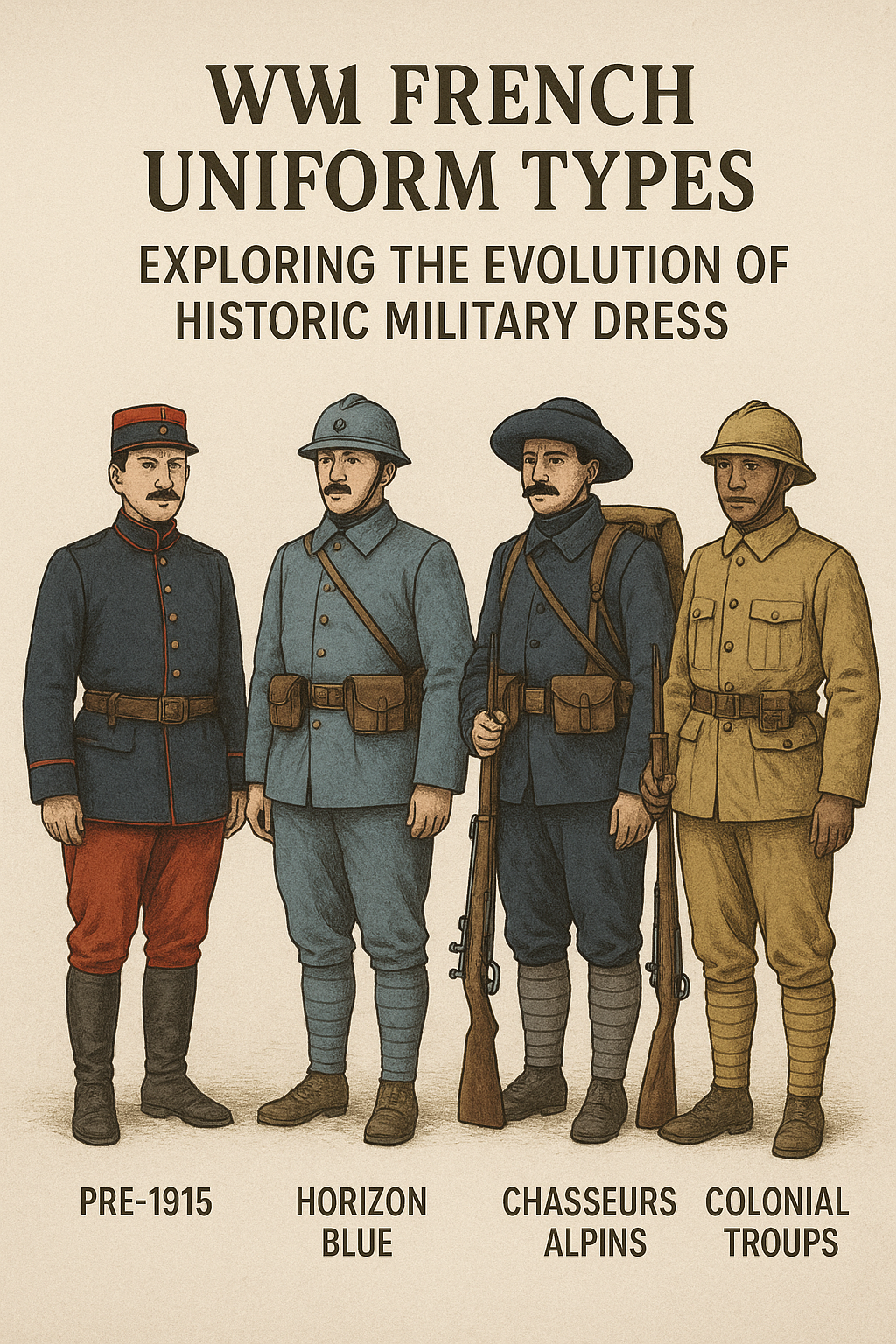
WW1 French Uniform Types: Exploring the Evolution of Historic Military Dress
Published on May 07, 2025
WW1 French Uniform Types: A Glimpse Into the Past
The uniforms worn by French soldiers during World War I tell a powerful story of national pride, battlefield necessity, and military transformation. While today we associate modern combat wear with camouflage and minimalism, soldiers during WWI often wore distinctive, colourful, and sometimes outdated uniforms—especially at the start of the war.
These historic military outfits have not only become a focus for reenactors and collectors but also serve as important artefacts for understanding the evolution of warfare. In this guide, we’ll examine the major types of WW1 French uniforms, their practical design elements, and how they compare to earlier military attire, such as the original continental army uniform.
Early WW1 French Uniforms: Bold but Risky
At the outbreak of World War I in 1914, French infantry soldiers still wore uniforms based on 19th-century military fashion. These included dark blue wool coats and bright red trousers, which were visually impressive but offered no camouflage or protection on modern battlefields.
Features of the 1914 French Uniform:
- Red trousers (pantaloon garance): A traditional colour choice dating back decades.
- Dark blue tunic: Formal and symbolically patriotic.
- Képi cap: Lightweight headgear that offered no real protection.
- White gaiters or black leather boots: Often polished and part of parade-style dress.
While these uniforms looked ceremonial and striking, they made soldiers easy targets amid the trench warfare and machine-gun fire that defined WW1. This would soon change.
The Introduction of Horizon Blue
In response to rising casualties and the need for more practical attire, the French military overhauled its uniform design in 1915. They introduced the now-famous Horizon blue uniform, designed to help soldiers blend into the smoky and dusty environment of trench warfare.
Key Components of the Horizon Blue Uniform:
- Capote modèle 1915: A longer wool coat in horizon blue (a greyish-blue colour).
- Matching trousers: Designed for better mobility and less visual exposure.
- Puttees: Strips of cloth wrapped around the lower legs for support and protection.
- Adrian helmet: France became one of the first nations to issue steel helmets, significantly reducing head injuries.
- Leather gear: Pouches, belts, and straps for ammunition and tools.
This shift marked a turning point in military fashion, where utility and protection took precedence over aesthetics.
Branch-Specific Uniform Variations
Not all French soldiers wore the same uniform. Variations existed depending on the branch, rank, and mission.
Infantry
- Standard issue horizon blue.
- Often carried a Lebel rifle.
- It may include insignia to denote division or regiment.
Artillery
- Reinforced coats and heavier boots.
- Some units retained darker blue coats.
- Protective gloves and ear covers for handling loud equipment.
Chasseurs Alpins (Mountain Infantry)
- Recognized by their dark blue uniforms and oversized berets.
- Specialized in mountain warfare and harsh weather conditions.
Colonial Troops
- Uniforms adapted for hot climates.
- Lighter fabrics in khaki or beige tones were used.
- Often served in African, Asian, or Middle Eastern theatres.
Each of these variations was designed with the soldier’s environment and mission in mind, showing a growing emphasis on specialization.
WW1 Uniforms Compared to the Original Continental Army Uniform
It’s fascinating to contrast WW1 French uniforms with the original continental army uniform worn during the American Revolutionary War. Though separated by over a century, both styles reflect the values and technological limits of their time.
AspectWW1 French UniformContinental Army Uniform
Era 1914–1918 1775–1783
Primary Color Horizon blue Blue with buff, brown, or white trim
Headgear Adrian helmet or képi Tricorn hat
Material Wool and metal Wool, linen, leather
Purpose Camouflage and protection Symbol of unity and structure
Footwear Boots with puttees Buckled shoes or boots
While the continental army uniform symbolized unity and defiance during America’s birth, the WW1 French uniform was born out of necessity and modern military strategy.
The Legacy of WW1 French Military Dress
The WW1 French uniform types remain iconic today—not only for their unique aesthetic but for their historical significance. They represent a critical moment in time when military forces were adapting to industrial warfare and the harsh realities of modern combat.
Collectors and historians often seek these uniforms because they offer:
- Authentic insight into military innovation
- Tangible connections to world history
- Aesthetic and cultural value
For reenactors and museums, preserving and displaying old military uniforms is more than a hobby—it's a commitment to educating future generations.
Why These Uniforms Still Matter
Understanding historical military dress helps us better appreciate the bravery and challenges of those who served. Uniforms like the WW1 French outfit are deeply symbolic—they signal rank, national identity, and adaptation in times of change. Their evolution mirrors the story of warfare itself, from ritualized honour to survival under fire.
Whether you're studying history, assembling a display, or simply fascinated by vintage military fashion, exploring these uniforms offers a window into the human side of war.
Conclusion
The WW1 French uniform types reflect a powerful transformation—from bright, ceremonial outfits to more functional, protective gear suited for modern combat. This evolution mirrors broader shifts in military strategy and societal needs during one of the most impactful conflicts in history.
Exploring these uniforms, along with related historic outfits like the original continental army uniform, helps us understand how fashion, technology, and warfare intersected during key moments in global history. More than just clothing, these uniforms symbolize national identity, innovation, and resilience.
Suppose you're passionate about military uniforms of old or simply want to learn more about the evolution of war attire. In that case, WW1 French uniforms are an essential starting point in understanding how soldiers once dressed, fought, and survived.
